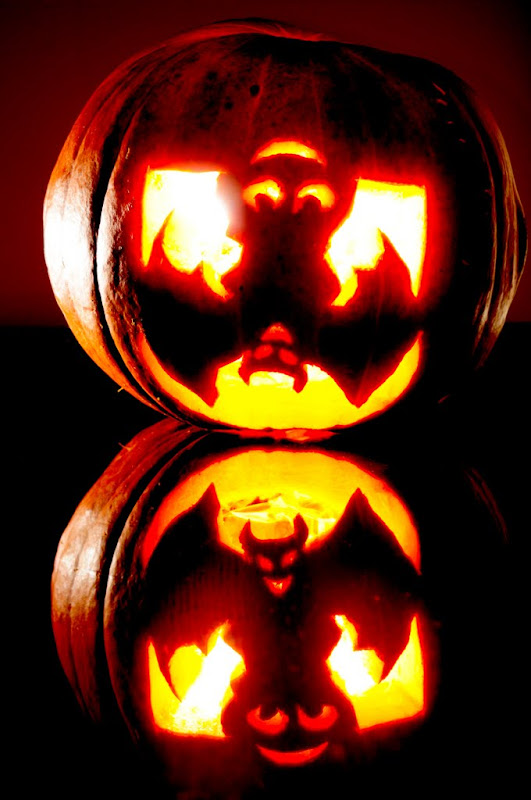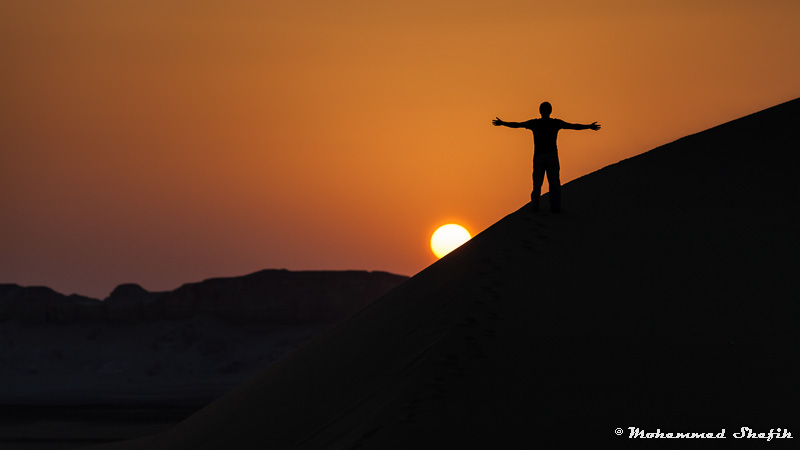
Here are some suggested settings for taking photos at Halloween.
BALANCING FLASH AND AMBIENT
Scenario 1: Dark Light
In this scenario, there is almost no ambient light on the subject. Flash will of course be the dominant light for the subject. This includes situations where the subject is backlit and the face of the subject has little or no light from the ambient.
a. Flash exposure: on TTL, start at 0 FEC then adjust to taste.
b. Ambient exposure: you can choose any exposure up to 1 stop below for the subject or the correct ambient exposure for the background, whichever is less. If you go above 1 stop below for ambient for the subject then be aware that flash blur may become a problem. If you go above the correct exposure for the background, the background will be overexposed.
- Choose manual exposure. Turn off Auto ISO.
- Aperture: go as wide as possible (taking into account the depth of field you need). A wider aperture will allow your flash to recycle faster and at the same time you can get enough ambient in the shot without needing a super slow shutter speed.
- ISO: if you are bouncing the flash, choose the highest ISO that is acceptable to you. Note: if you have a very wide aperture and very high ISO, you may get flash overexposure because the TTL cannot go below a minimum threshold. If that happens, adjust ISO and/or aperture.
- Shutter speed: you can slow down the shutter as needed to allow enough ambient to show up in the shot, up to 1 or 1.5 stops below for the subject or the correct ambient exposure for the background, whichever is less. As long as you don't go above 1 or 1.5 stops below for the subject, the subject will be sharp because the flash duration will freeze the subject. Note that with a slower shutter speed, the background will become more blurred (unless you're using a tripod).
Scenario 2: Dim Light
In this scenario, there is some ambient on the subject but it's not bright enough to serve as the dominant light source. Flash will still be the dominant light. The difference is that flash blur can become an issue.
a. Flash: on TTL, start at 0 FEC then adjust to taste.
b. Ambient exposure: you can choose any exposure up to around 1 stop below for the subject or the correct ambient exposure for the background, whichever is less. If you expose above 1 stop below for ambient for the subject then be aware that flash blur may become a problem. If you go above the correct exposure for the background, the background will be overexposed.
- Choose manual exposure. Turn off Auto ISO.
- Aperture: go as wide as possible (taking into account the depth of field you need). A wider aperture will allow your flash to recycle faster and at the same time you can get enough ambient in the shot without needing a super slow shutter speed.
- ISO: if you are bouncing the flash, choose the highest ISO that is acceptable to you. Note: if you have a very wide aperture and very high ISO, you may get flash overexposure because the TTL cannot go below a minimum threshold. If that happens, adjust ISO and/or aperture.
- Shutter speed: since there will be some ambient on the subject, don't go any slower than about 1/60. If you go slower than that, be aware that there will be some blur from the ambient on the subject. The blur can sometimes add to the effect but generally I try to avoid it. Faster would be better but do not go above the sync speed or else you will be reducing the effective output of your flash.
Scenario 3: Bright Light
In this scenario, there is enough ambient light on the subject. You have a choice of using flash or ambient as the dominant light source. If flash will be the dominant light source, then use the formula in scenario 2. If you want ambient to be the dominant light source, then here is a suggested procedure.
a. Adjust the ambient exposure to expose correctly for the subject.
- I would not mind using aperture priority with auto ISO turned on. However, you can use manual exposure as well.
- Aperture: go as wide as possible (taking into account the depth of field you need).
- Shutter speed: use a high enough shutter speed to freeze the subject to get a sharp photo. At a minimum I would use 1/125, preferably 1/200 or 1/250. Don't go above the sync speed or else.
- ISO: choose the highest ISO that is acceptable to you.
b. Flash: flash will be acting as fill. On TTL, start at -1 FEC then adjust to taste.
CONTROLLING COLOR, DIRECTION, AND QUALITY
If you want the shot to look natural, balancing flash and ambient is just one part of the equation. You also need to mind your flash color, direction and quality.
Color: At night there is rarely a natural source of white light like that of flash. Using an ungeled flash will make the flash use obvious. To simulate the light from the environment (probably lit by lamps), use a CTO or CTS gel, or bounce from a yellowish surface. Alternatively, you can use a blue or green or other unusual gel color for effect (don't do it on all the shots).
Direction: Choose a flash direction that is flattering and logical.
- Generally, a safe direction is to position the flash high and aim downward for a butterfly lighting effect.
- If you want to position the flash to the side, it has to make sense - are you simulating a fireplace for example? If so, you need to gel it appropriately as well.
- If the subject is wearing a wide-brimmed hat (e.g. a witch's hat) then of course the hat would block light coming from above, so instead consider using bounce flash from the front or off to the side, to simulate light reflecting off the ground or a nearby wall.
Quality: Usually soft light is more flattering but because it's Halloween, you can probably get away with hard light. Just make sure to keep motivation in mind (i.e., try to make the appearance and characteristics of the light logical).
OTHER EFFECTS:
Separation light: With black or dark costumes, one issue is getting enough separation between the subject and the background. Choose a background with enough ambient light so that the background can contrast with the costume. Another strategy is to find a place where there is an existing light source (e.g. lamp, etc.) that can serve as backlight, shoulder light, or kicker. Or ask someone to hold a flash off-camera as a kicker.
Volumetric lighting: If there is a fog, smoke or mist, you can backlight the fog with off-camera flash for a dramatic effect. You can light the fog either directly behind the subject or from above and behind the subject.
RELATED POSTS:
Pumpkin Carving - how I took the pumpkin shot above
Haunting Halloween Portraits - scary Halloween-themed fashion/portrait session
Taking Halloween Pictures - some Halloween shots I took 3 yrs ago, what went right and what went wrong.


























































